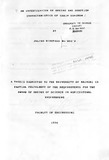| dc.description.abstract | Published data on sorption and drying characteristics of
sorghum grains is inadequate and scattered over temperature
and relative humidity ranges. There is need to generate more
data, test it on the existing models, and to develop new
models that can fit a wide range of temperature and relative
humidity
Sorption data for adsorption and desorption of water by
sorghum grains were obtained at 2SnC, 40nC, 55°C and 70ne over
a relative humidity range of 0.11-0.97, using a static
gravimetric method. The experimentally obtained data for three
sorghum varieties (White, Brown and Red) were used to evaluate
the suitability of BET, Halsey, Henderson, Oswin, Smith and
GAB sorption models. The models'
using an iterative non-linear
parameters
computer
were computed
program. The
experimental data was also fitted to an empirical model using
multiple regression analysis and the results were compared to
those from the above models. Mono layer moisture contents for
the three varieties were determined from BET and GAB models.
The equilibrium moisture content (EMC) of grain sorghum was
found to be independent of variety but was dependent on
temperature. Both desorption and adsorption isotherms were
sigmoid in shape (BET type I I) and exhibited hysteresis
phenomenon. Comparison between the empirical model and the
other models indicated that no model was significantly
superior to the empirical model. The GAB model fitted the
sorption data over the entire relative humidity range better
than all tested models. The ranking based on order of best fit
was as follows: 1. GAB; 2. Henderson; 3. Empirical; 4. Oswin :
5.Smith; 6.Halsey; 7.BET.
Drying characteristics of both naturally moist and rewetted
grain sorghum were also studied. Drying air temperature ranged
between 40 c and loo c. Two air flow rates were used. Thin
layer drying equations based on Pabis and Henderson equation
and Page model were developed. Drying air temperature was the
major factor affecting drying rates of sorghum grains. The
difference in sorghum varieties also influenced the drying
rates. These differences were more pronounced at high air flow
rates. The relationship between parameter k in Pabis and
Henderson equation and drying air temperature was found to be
of Arrhenius type. Parameter K in Page equation, for naturally
moist grains, was expressed as an exponential function of
temperature terms. But for rewetted grains, it was an
exponential function of temperature terms, air flow rate,
iv
relative humidity and initial moisture content. Parameter N in
Page equation was expressed as an exponential function of
temperature. Page equation fitted drying data better than
Pabis and Henderson equation. | en |

